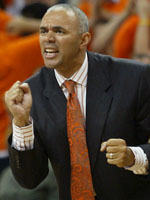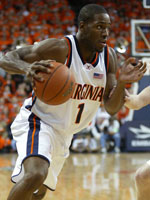 |
|
Coach Dave Leitao is looking for his 100th career win in tonight’s game at Purdue. |
O.K. Football season just ended. You’ve been drawing up post patterns and trick plays in the bean dip during Saturday games until now, but suddenly football season is over and you’re ready to shift into high gear with basketball. What’s that? You feel like you’re out of the loop? You need a crash course on Dave Leitao’s Cavaliers?
No problem, I’ve got you covered. Here are 5 quick questions and answers to fill you in on the Hoos as they play in the ACC/Big 10 Challenge later tonight.
1. Who are the first mates? Captains J.R. Reynolds and Sean Singletary are well known to just about everyone. They shoot, score, pass, dribble, and defend – and they do it at a high level for pretty much the whole game. Singletary averages 17.0 points, 7.5 assists, 4.5 rebounds, and 1.25 steals so far this season. Reynolds checks in with averages of 16.8 points, 3.75 assists, and 3.3 rebounds.
So who are the first mates on this ship? In other words, who else can score for this team, especially on the road where the Hoos struggled so much last year?
So far this season, Mamadi Diane and Jason Cain have taken on those roles. In the Cavaliers’ 4-0 start to 2006-07, Diane has averaged 16.3 points per game on 65.6% shooting; that includes making 10 of 18 shots from 3-point land. Cain, meanwhile, broke out against Maryland Eastern Shore, boosting his scoring average to 12.3 ppg on 65.5% shooting. The Hoos will need both of those players to continue that performance if they are going to win on the road.
2. Who usually starts? Good question. With a lot of injuries, particularly on the front line (Laurynas Mikalauskas sprained both ankles and Tunji Soroye had sports hernia surgery), the Cavaliers have deployed a small, veteran line-up at the start of games for the most part. It features Singletary, Reynolds, Diane, Adrian Joseph , and Cain. Of course, Joseph did not play in Sunday’s most recent game because he rolled an ankle during shoot-around. He could be available tonight, but he may not start. If he doesn’t get the nod, who does? It could be either Mikalauskas or Ryan Pettinella so that Cain can move back to his traditional power forward slot.
 |
|
Will Harris is emerging as a key piece of the Hoo puzzle. |
3. So what about the subs? I must admit, that’s a logical follow-up question. So far this season, Leitao has used substitutions liberally. So far this season, 15 players have seen action and even if you subtract the walk-ons, that number still clicks in at 11. That tells us that lots of players may get a chance, but the official rotation may be determined by that week’s practice or previous games.
What about tonight at Purdue then?
The basic things to watch involve the point guard slot and the small forward/power forward slot. When Singletary takes a breather, Reynolds moves over to the point. That means that Diane usually takes over at the two, leaving the small forward position to Will Harris , Solomon Tat (if he’s available – he has only played against Arizona this season as he is nursing a groin injury), Joseph, and possibly Jamil Tucker in a “big” line-up. Any of those players could fill the three in different rotations as well.
That moves us to the PF spot. Cain spends most of his minutes there with a few at the center position. He could get more C minutes tonight because Purdue is a smaller team than some other opponents. Regardless, the other options on the front line include Joseph and Harris (in small line-ups) or some combination of Mikalauskas, Pettinella, Tucker, and Jerome Meyinsse .
Keep in mind that this is the first road game for many of the players so Leitao may choose to go with veteran line-ups at critical times. That was the case in the second half against Arizona. In the season-opening win, the veteran players logged more minutes because of the experience factor. That means lots of Singletary, Reynolds, Diane, Joseph, Mikalauskas, and Cain. Harris and Tat, both of whom are chiseled-looking players, could also factor into those scenarios because of their physical maturity.
4. What statistics are the most important? I know there are some stat line junkies and GameTracker users out there so let me give you the boxscore tutorial for watching Virginia.
 |
|
Sean Singletary and the Cavs have to limit turnovers. |
Let’s start with the important ones as related to Singletary – minutes played and fouls. Admittedly, those are directly tied to one another. If Singletary gets in foul trouble (and he hasn’t so far this season), that means Reynolds as to play a lot more time at the point and that’s not good for the Cavaliers. That’s not a knock on Reynolds, but it Singletary makes the game faster and makes his teammates more productive.
The next thing to keep an eye on: turnovers. UVa wants to run the floor and create more shots. Simply put, you don’t get more shot attempts if you give the possession away through a turnover. Realistically, you’re probably not going to have a 100% success rate with one shot per possession (which is why offensive rebounds are such an important stat as well – O-boards essentially add possessions and get you closer to that 100% mark).
A simple way to get a handle on the approximate number of total “possessions” is to add a handful of statistical categories – field goal attempts, free throw attempts divided by 2, offensive rebounds, and turnovers. This may not give you the exact number of possessions because of the free throws; a traditional three-point play or being fouled on a 3-point shot could alter the possession numbers slightly. Regardless, you get a rough idea of how many possessions there were in the game. Then divide the number of turnovers by the number of possessions to get a percentage.
Let’s use the Eastern Shore game as the example. UVa had 62 field goal attempts, 35 free throw attempts or 17 when divided by 2, 18 offensive rebounds, and 19 turnovers. Added together, that equals 116 possessions. Using our formula, that’s a turnover 16.4% of the time or once every six possessions; I’d consider that an acceptable number at the pace of play. However, the goal should be in the 10 to 13% range, which would have been 15 turnovers in this example.
The last thing to look at is field goal percentage. The Cavaliers’ road woes of 2005-06 can be directly tied to poor shooting away from Charlottesville. Late last season, we examined that fact in a “Troubleshooting: A Road Fix?” EDGE article. It basically revealed that UVa shot better than 45% at home and less than 39% on the road. That won’t get it done so look for a number in the 43-47% range tonight if the Cavs are expected to be competitive and win.
5. How have the Hoos fared in the ACC/Big 10 Challenge? In general, this event has been a good one for Virginia. The Hoos are 4-2 in the Challenge, including three straight victories. In the past two conference match-ups, UVa topped Northwestern and before that, the Cavs topped Minnesota in 2003-04.
The Cavaliers have also had success against tonight’s opponent Purdue in this event. In 2000, they knocked off the Boilermakers 98-79. There’s more good news there for the Hoos. That game was also on November 29. Still, don’t expect tonight to be a breeze. Purdue is 4-1 this season after winning just 9 times all of last year.
This is a free sample of what Edge subscribers receive through their subscription. Sign up for the Sabre Edge to receive the most complete coverage that’s full of analysis about the Cavaliers. Sign Up Today!



